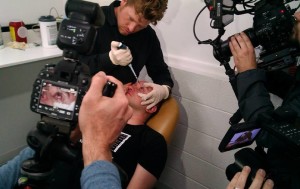
Any superhero worth his or her salt has night vision: Doctor Mid-Nite, Wolverine, Peter Parker, Superman, Catwoman. Regular humans have desired this power for quite some time—night-vision devices have been around since World War II. But most of them look more like binoculars than anything else, though some of them do mount on a helmet for hands-free use. Still, who wants a bulky gadget when slinking around in the darkness? Not superheroes. And not Science for the Masses, a California-based biohacker group that has developed a high-tech eye drop that allows humans to see in the dark.
Their approach was simply to enhance eyesight so much that a person could see in the dark. Like many scientists, the group was inspired by nature—namely, deep-sea fish that have adapted the ability to see in the pitch black of the ocean bottom. These fish produce a type of chlorophyll called Chlorin e6 (Ce6), a naturally-occurring molecule and photosensitizer. Ce6 has had various medical purposes over the years, both for vision and for cancer treatment.

In their recent experiment, researchers conducted what amounts to the longest eye-drop session ever. One of the researchers, Gabriel Licina, volunteered to have his eyes stretched open and to have a relatively small dose (50 microliters) of Ce6 dripped into them, specifically into the conjunctival sac that allows for speedy passage to the retina. Licina reported seeing a dark blur which quickly absorbed into his eyes.
After about an hour, they went out to test the effects, conducting three rounds of “subjective testing” involving three stages of assessment: recognizing symbols from a distance, recognizing symbols against various backgrounds at the same distance, and recognizing moving objects against different backgrounds at different distances. At first, Licina was able to discern shapes roughly the size of his hand from about 30 feet. Then they increased the distances, and still Licina could see the objects, even when they were small. For another test, people walked into the woods and stood among the trees—a particularly tough background when it comes to distinguishing objects in the dark and at a distance. Still, Licina was able to distinguish people from trees from about 160 feet away with 100% accuracy. The control group, which hadn’t been dosed with Ce6, was able to perform the same identification roughly 33% of the time. The group has documented and released its findings.

The group plans on doing more testing and lab experimentation and hopes to quantify the effects of the Ce6 with hard numbers, especially what happens in the user’s eye when it comes to electrical stimulation and light augmentation. The project’s success demonstrates that we don’t have to wait for companies with deep pockets to start testing this kind of stuff. “There are rules to be followed and don’t go crazy, but science isn’t a mystical language that only a few elite people can speak,” says the group’s medical officer, Jeffrey Tibbetts.
Deep-sea fish aren’t the only creatures that can see in the dark. It’s not as pleasant of an association for most people, but some of nature’s most famous night-seers are also some of the grossest: cockroaches. While they’re pretty disgusting, especially because their excretions contain allergens that can cause reactions or trigger asthma attacks, they can do a whole slew of awesome stuff, like live without water for a month and without food for three months. They can survive radiation (if you want to test this out, pop a cockroach in the microwave) and can live without a head for a number of weeks. I’m not sure why some of the most vile creatures are also the most resilient (bed bugs come to mind as well), but who are we to question nature, especially when we can try to replicate it? To that end, cockroaches’ ability to see in the dark is a little different from those animals that benefit from Ce6. The cockroach approach is more akin to time-lapse photography, according to Finnish physicists who recently conducted experiments on the insects’ night vision.
What’s even cooler about this experiment is that the researchers used virtual reality to test the night vision of 30 American cockroaches. They put the roaches on a tracking ball in a room that they darkened incrementally, in front of a curved screen onto which they projected black and white stripes. As the stripes moved, the roaches walked toward them. To assess how much light the roaches were able to detect in these dark conditions, researchers put microelectrodes into one of the roaches’ eyes and recorded the activity in the photoreceptor cells, which are activated by light particles. In a room roughly as dark as the outdoors when there’s no moon lighting the way, the roaches’ photoreceptors received one photon every 10 seconds.
That’s not a lot—humans couldn’t see by that amount of light. But the roaches could. The researchers concluded that the nervous systems of the roaches collect information from its photoreceptors over an extended period of time, using the amassed neural signals to see in the dark. Dung beetles have a similar strategy (they also navigate at night using the Milky Way, which is pretty awesome).
Researchers aren’t entirely sure how these insects are able to do this, and night vision technology could benefit from them figuring it out. But until then, eye drops seem like a better idea—borrowing an approach from deep-sea fish sure seems less icky than borrowing an approach from one of the most detested household pests around. One of the drawbacks to seeing in the dark, though, would be the ability to see these light-averse creatures before they scatter. Maybe there are some things humans aren’t meant to see.


Pingback: The future is going to be weird, but at least Joelle Renstrom is here to explain it to us | Source All Buzz